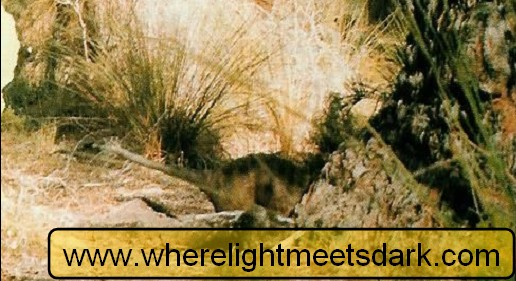Cameron thylacine - initial analysis
Kevin Cameron's photographs of a thylacine are, at the least, very interesting. They appear to show the rear half of a juvenile animal, its head obscured behind the butress root of a tree.
The photograph shown here (click to enlarge) was published in New Scientist 24 April 1986 and taken in February 1985 in south-west Western Australia. From the accompanying article, "Accepted scientific knowledge is ... completely against Kevin Cameron, but he has a set of five photographs taken in dense forest in the south-west of Western Australia, and some casts of the animal's footprints. The scientists may be incredulous, but I believe Cameron's finds are authentic.
Kevin Cameron is of Aboriginal descent. He takes pride in his ancestry, his bushmanship, and his knowledge of Aboriginal culture. He is intelligent, but until recently was illiterate. So he could not have learned about the thylacine in libraries. I find it inconceivable that anyone with his background could possess colour photographs of a thylacine as well as the casts and his detailed and exact knowledge of the animal, unless he has actually seen a thylacine.
The photographs are genuine. Dr Ronald Strahan, formerly director of the Taronga Park Zoo in Sydney and now at the Australian Museum, has also seen the pictures. He agrees with me that they are authentic and could be nothing other than a thylacine."
Despite this show of support for the authenticity of the images, other reports on the web claim that readers of that issue of New Scientist wrote quickly to point out that the shifting shadows in the image indicate the photographs must have been taken up to several hours apart - an unlikely situation for a living thylacine.
Had Kevin Cameron shot the animal? One photo in the magazine clearly shows (and describes in the caption) a discarded rifle in the foreground. Killing thylacines is illegal and it seems that following these photographs no further information was revealed.
An earlier news article is included in the New Scientist piece with the title "Tracker's claim ignored". An emphasised caption reads "Government is blocking hunt because habitat is mining land".
Could this be the real reason nothing more was said by Cameron regarding the location of these photographs? Dead or alive - does anyone know what follow-up investigation was conducted on the basis of these photos? Back to the question at hand - are they in fact genuine?
(More to come - an up close analysis of the Cameron photographs and comparisons with known thylacine images).
